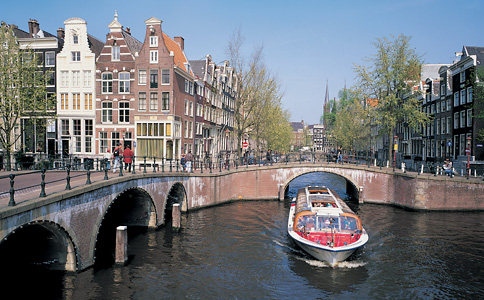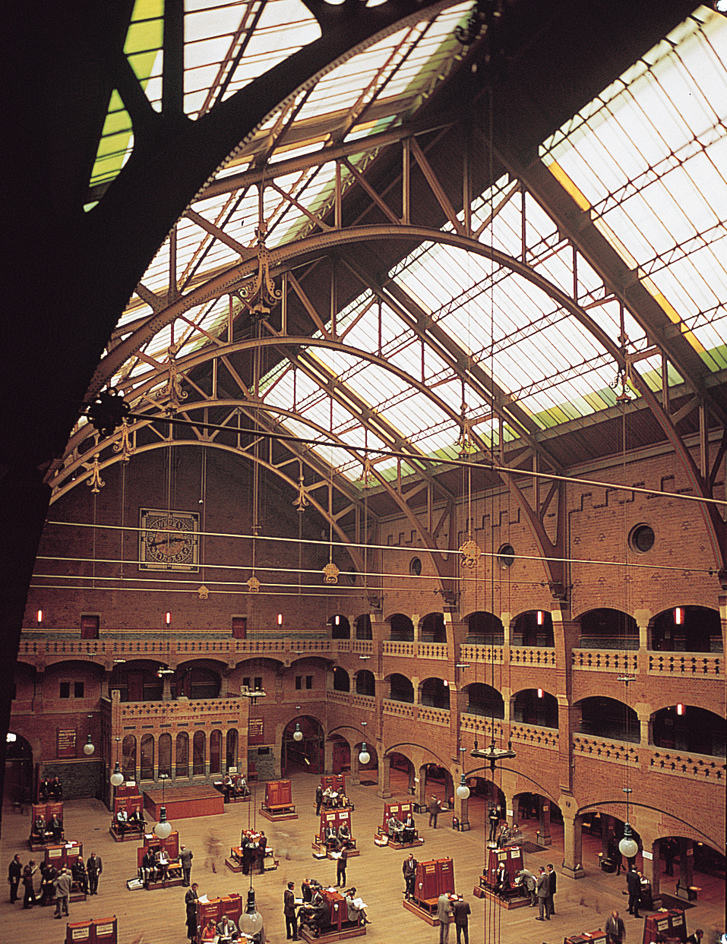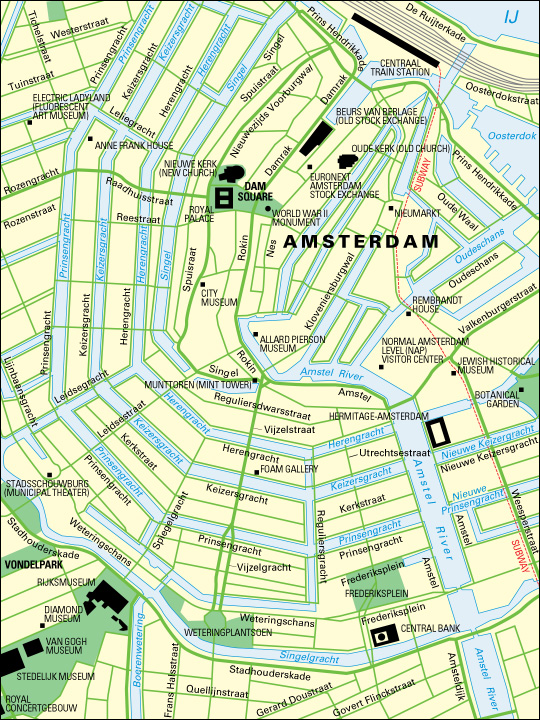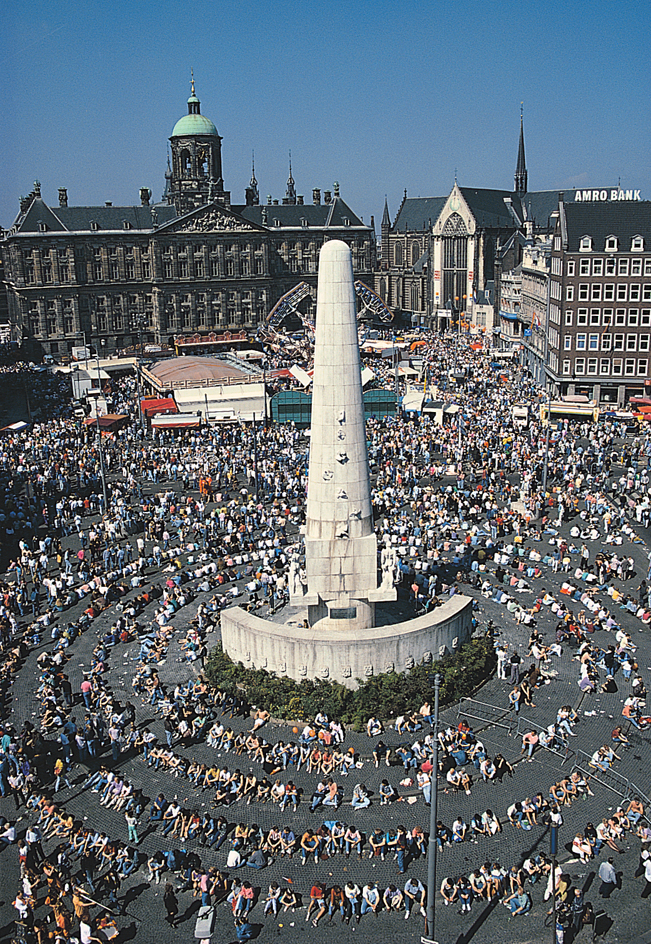Amsterdam (pop. 810,937) is the capital and largest city of the Netherlands. It lies at the junction of the Amstel River and the IJ, an arm of a large lake called the IJsselmeer. The city’s name means dam of the Amstel and refers to a dam built there in the 1200’s. Amsterdam is the national capital, but the seat of government is in The Hague, 34 miles (55 kilometers) away. Amsterdam’s residents come from more than 150 different countries. 
The city
lies on marshy land slightly below sea level. Most of its buildings stand on large wooden or concrete piles (posts) driven into the soggy ground. More than 100 canals crisscross the city and help drain the land. The canals and attractive buildings help make Amsterdam one of Europe’s most charming cities.

The old section of Amsterdam lies at the heart of the city. This section is a jumble of narrow streets, many of which are closed to automobile traffic. Some of its buildings date from the Middle Ages. The Royal Palace, built in the mid-1600’s, overlooks Dam Square at the center of the old section. Next to the palace stands the Nieuwe Kerk (New Church), where the nation’s monarchs are inaugurated. The church was built in the 1400’s. The city’s stock exchange, founded in 1612, is nearby.
The IJ and the port area are just north of the old section. Three canals—the Herengracht, the Keizersgracht, and the Prinsengracht—border the old section on the east, south, and west. Impressive mansions, built during the 1600’s by the city’s merchants, line the canals. Many of the mansions are now banks or office buildings. Beyond the canals are large neighborhoods and suburbs built during the 1800’s and 1900’s.
Amsterdam’s major cultural attractions include the Rijksmuseum, Amsterdam’s principal art museum; the Stedelijk Museum, a municipal museum of modern art; and the Van Gogh Museum, which features many works by the famous Dutch painter Vincent van Gogh. Amsterdam also has a municipal theater, two universities, and the world-famous Royal Concertgebouw Orchestra.
Economy.
Amsterdam’s economy is based on financial services, manufacturing, tourism, and foreign trade. The city is the headquarters of the Netherlands Central Bank, the nation’s major commercial banks, and many insurance and investment companies. Amsterdam’s stock exchange is part of Euronext, an exchange serving all of Europe. The city’s industries include aircraft manufacturing, electronics, food processing, publishing, ship repairing, and production of chemicals and steel. Few other cities attract more foreign visitors than Amsterdam. Canals link the city to the North Sea and to the Rhine River, Europe’s chief waterway. Schiphol Airport lies south of Amsterdam.

History.
Amsterdam was founded about 1200 as a fishing village. A dam was built there during the 1200’s. The village then became the point for cargo transfers between seagoing ships on the IJ and boats on the Amstel River. By the 1400’s, Amsterdam had developed into a prosperous center of European trade.
The city began to grow rapidly in the 1580’s. During that period, and for about the next 100 years, thousands of political and religious refugees fled to Amsterdam to escape persecution. They included Jews from Portugal and Protestant merchants from Antwerp and other cities in Flanders. They helped establish a variety of industries and trade links. The city’s trade spread to Africa, the Americas, the East Indies, and elsewhere. Amsterdam was Europe’s greatest trading center during the 1600’s, and the city’s cultural life also flourished.

During the 1700’s, Amsterdam developed into a great financial center. Its bankers lent money throughout Europe, especially to foreign governments. France took control of the Netherlands in 1795 and made Amsterdam the capital in 1808. But the Dutch restored their government in The Hague after they regained independence in 1813. Amsterdam’s economy was ruined during the period of French rule, but the opening of the North Sea Canal in 1876 helped revive it. The city’s population doubled from 1850 to 1900.
Amsterdam’s people suffered greatly during World War II (1939-1945). The city was occupied by German troops, and its Jewish community was almost wiped out in Nazi concentration camps. Roughly 60,000 of the city’s 75,000 Jews died during the war, including the young diarist Anne Frank. The city also suffered a severe famine during the winter of 1944, and thousands starved.
Amsterdam had a housing shortage for many years after World War II. To relieve overcrowding, several carefully planned residential areas were built on the outskirts of the city. One such project, constructed in the 1970’s, was a massive apartment complex designed to house 100,000 people. A subway was built to connect the complex to the old section of the city.
In the 2000’s, Amsterdam’s leaders worked to balance the interests of tourism-based businesses with the needs of local residents. A major project to rebuild hundreds of miles of deteriorating canal walls began in 2021.

